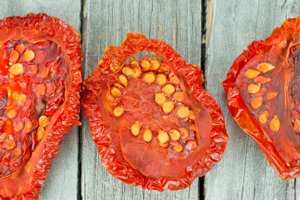Dehydrating Foods
Without Electricity
Dehydrating foods is a simple, low-cost way to preserve all types of fresh food, including fruits, vegetables and even meats. And while an electric food dehydrator is handy, dehydrating these foods without an electric dehydrator is a time-proven tradition that has been carried out around the world for centuries.

The dehydrating process simply removes the moisture from food so dangerous bacteria can't grow. If you live in the arctic or the desert where the air is dry all the time, not a problem. Simply cut your food into thin strips, cover it with a clean cloth to keep the bugs away and expose it to the air for several hours until the food snaps when you bend it.

But if you live anywhere else on the planet, you will need heat to dry the air. This can be done in a number of ways, many of which don't require electricity.
Dehydrating Foods Using
The Car Method
It's not just a transportation device; your car can also make a dandy tool for solar food dehydrating, using the sun for dehydrating fruits and vegetables. Park your car in the sun, and even in winter it will often get warm enough to dehydrate food.
You will want to crack the windows to allow the moist air to escape. Slice your food into thin strips and place it on trays, making sure the pieces don't touch each other. For fruits such as bananas or apples that turn brown when exposed to air, dip each piece in lemon juice before setting them on the tray.
Cover your food with cheesecloth or other clean, light cloth to keep the bugs out and set the trays in the back seat of your car for one to two days. Bring your food in at night and set it back out in the morning of the second day.
Your vegetables are sufficiently dried if they snap when bent. Because fruits have a larger sugar content, look for a firm bend or a leathery quality, although if they do get brittle, they will still be fine for eating.
Dehydrating Foods Using the Solar Method
Similar to the car method, solar food dehydrating requires building a solar dehydrator for dehydrating foods, which is typically a box with glass on top to let the sun in, screen trays to allow the air to flow about the food, and vents to let the moist air escape.
Again, prepare your food and then cover it with either cheesecloth or even netting material (like the kind that is used in a bridal veil).
Place the food on food-safe plastic screens (you can find them online here). Place them in your solar dehydrator and make sure the dehydrator is facing south to get the most exposure to the sun.
Dehydrating Meat Without Electricity
If you can't afford a dehydrator with a thermometer (definitely the simplest way of dehydrating meat), then your next best option is to cut your meat into strips and dry them over coals. Dig a hole in the ground and start a fire using hard wood. Don't use soft woods such as pine because it has pitch that will taint the meat.
Cut the meat in the same direction as the muscle about 1 inch wide and one-fourth an inch thick. Be sure to trim all fat off the meat or else it won't cure properly and spoil the meat. Soak your meat for about an hour in a solution of 1 quart of water and 1/8 cup of salt, stirring the strips every fifteen minutes to make sure the salt water is saturated into the meat.
When the firewood has burned down to hot coals, hang the meat two feet above the coals using two stakes and a pole or piece of wire stretched between the two stakes. The air around the meat should feel hot, but not burn your hand. Your goal is to dry the meat, not cook it, with just enough heat to destroy any harmful microorganisms in the meat.
Add a few damp hardwood chips to the coals to make smoke. The smoke will put a protective coating on the meat and keep the birds and insects away. You will need to keep the coals burning for several hours until the meat is sufficiently dried.
Properly Storing Your Foods
Once you are finished dehydrating foods, store them properly and they will last up to a year. Either vacuum seal them in jars, if you have a vacuum sealer, or store them in quart-sized freezer bags. Place the food in the bags, press out all the air and seal. Then put the sealed bags in a five-gallon plastic container and cool in a dark, cool place.
Learn More Food Dehydrating Tips
Learn More About Dehydrating Meat








New! Comments
Have your say about what you just read! Leave me a comment in the box below.